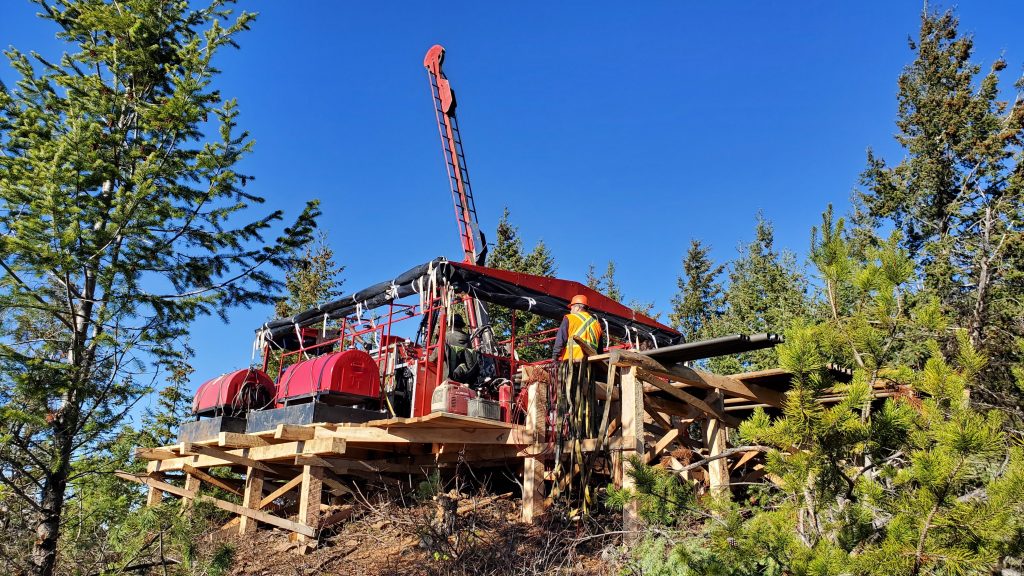Evergold conducting follow-up drilling at DEM Project, British Columbia

Evergold Corp. [TSXV: EVER; WKN: A2PTHZ] reported that drilling has begun at the company’s road-accessible DEM prospect, located in central British Columbia near Fort St. James, in follow-up to last season’s precious (Au, Ag) and strategic metals (Co, Mo, Cu, W, Te, Re) discovery.
The program will encompass up to 1,000 metres of drilling in multiple holes targeting a prominent north-south geochemical and geophysical trend, part of the much larger 4 km2 geophysically and geochemically anomalous DEM target area, with completion anticipated in October.
The drilling will build upon the encouraging results of the Company’s DEM reconnaissance drilling (947 metres in 3 holes) carried out in fall 2023 on the same trend. As highlighted below, the three holes drilled in 2023 intercepted what is interpreted to be a roughly north-south oriented, structurally-focused, epithermal-style and locally sulphide-rich system, comprised of a broad envelope of anomalous to low-grade mineralization encompassing genuinely high-grade intervals of both precious and strategic elements.
With better focused and better framed targets evident from recently completed geophysical surveys, the company is excited at the prospects for this year’s drilling. Helping to generate that excitement is a large underlying sub-circular magnetic feature, akin in plan view to a doughnut, which extends well beyond the limits of the currently targeted core area geochemical-geophysical trend. The broad coverage area and unique character of this underlying magnetic response, together with a first intercept in last year’s drilling of a porphyritic dyke mineralized with very high-grade molybdenum plus significant credits of gold, silver and high-value rhenium, suggests the possibility that the epithermal assemblage may be associated with an underlying and/or nearby intrusion.
“Last year we tested the DEM prospect from two pads located a long way apart,” said Kevin Keough, President and CEO. “Intercepts in the holes drilled from those pads have given us an apparent trend to what we believe is essentially a high-grade system, possibly tapped into an underlying intrusion, which appears to trend subparallel to the best of the surface geochemically anomaly and almost certainly daylights within the DEM core area geochemical-geophysical trend. We’re especially interested in two high-order CSAMT (low resistivity) anomalies defined since last year – designated Features “A” & “B” – with associated high IP chargeability, located between and immediately to the south of, last year’s drill sites. The location of these anomalies suggest that we may have narrowly missed with last season’s drilling, which was the first on this generally poorly-exposed property. Therefore, with this year’s initial drill plan, we’ll initially target the Feature A anomaly from Pad A, drilling west down the high chargeability/low resistivity anomalies to a target depth of 250 metres. With success, more than one hole may be drilled from Pad A. A second drill pad – Pad B – has been sited 100 metres due west of Pad A along the same section 68000N. Additional holes will be sited depending upon visual and XRF analysis of core in the field.”
Previously released highlights of the 2023 drill program:
DEM23-01: Partially delineated system envelope: 135 metres of 0.12 g/t Au from 6 to 141 metres, true width unknown, including: high-grade strategic metal tungsten (0.32%) and silver (155 g/t) from 131 to 132 metres.
DEM23-02: First intercept of porphyritic intrusive: very high-grade strategic metal molybdenum (0.82%), with associated gold (1.2 g/t), silver (8 g/t), and high-value rhenium (3.7 g/t) from 299 to 300 metres, true width unknown.
DEM23-03: Partially delineated system envelope: 48.2 metres of 0.58 g/t Au and 11 g/t Ag from 303 to 351.2 metres, believed to approximate true width, including high-grade: 11.98 g/t Au, 24 g/t Ag from 339 to 340.5 metres, including high-grade: 29.5 g/t Au, 0.11% Co, 0.19% Cu from 340 to 340.5 metres.
Due to 2023 budget constraints, only 62% of the metres drilled in DEM23-01 were assayed, 17% in DEM23-02, and 12% in DEM23-03, with the focus being on only those core intervals that showed the highest density of veining, sulphides, and metal values indicated by X-Ray Fluorescence (XRF). The company intends to sample and assay 100% of the core drilled in 2024.
The 12,728-hectare DEM property is ideally located in moderate terrain 40 km northwest of Fort St. James in central B.C. The project area lies toward the south end of the Nation Lakes porphyry camp and within the Quesnel terrane, the latter of which hosts large deposits and long-life mines.
Located central to the DEM property is the DEM1 prospect, a roughly 4km2 target area defined by alteration and mineralogy suggestive of the presence of a porphyry system, by a multi-element soil geochemical signature, by compelling high-relief magnetic, IP-chargeability and CSAMT resistivity anomalies, and by the presence of nearby regional scale structures.
